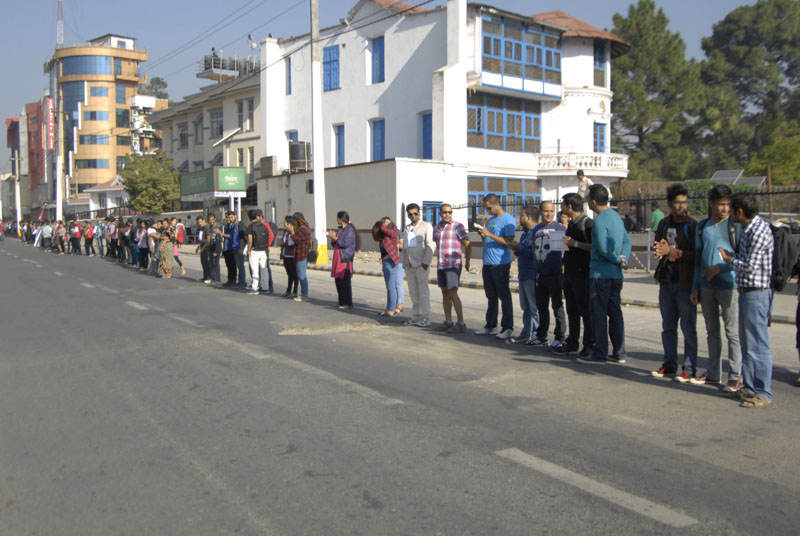Human chain symbolising Nepal’s unity in diversity
Over 500 turn up for this symbolic campaign calling for an end to nation’s polarisatio
KATHMANDU: Holding each other’s hands on the morning of October 9, more than 500 enthusiastic youth formed a human chain in the Capital. From Maitighar Mandala to New Baneshwor, the people who turned up for the ‘Nepali Youth Solidarity Movement’ showed their solidarity towards the need for communal harmony among Nepalis. The youth, from different walks of life, even requested pedestrians watching their ‘movement’ to join in.
As they formed the human chain, the participants held up sheets of paper with the slogan ‘Sadaka Lagi Sadbhav’ (Harmony Forever) as well as their demands. The demands included — ‘We demand our government and political parties to welcome the demands of Madheshis/Tharus and Janajatis on the table. The government may or may not agree with their demands, but they have no right to kill innocent citizens. We demand the government to sit in peaceful and meaningful dialogue with dissenting political parties and not use brute force against citizens. We demand political parties centred on Madheshis/Tharus and Janajatis issues to behave responsibly as citizens of Nepal and settle all disputed issues sitting gracefully with our government. We demand our neighbours to immediately stop interfering in the affairs of our country.’
Following instructions given, participants clapped hands in unison. But with no pins to pin it on their clothes, many got confused whether to hold up the slogan paper or to clap. Many had turned up with Nepali flags — big and small. Then there were people pumping more energy into the participants chanting slogans like ‘We love Nepal’.
The programme ended when all participants gathered again at Maitighar Mandala, sang a few patriotic songs and chanted ‘We love Nepal’ along with clicking photographs.
Chanda Sharma, one of the participants expressed, “I feel proud to be a part of this event which is not limited to Facebook only. I had fun as well.”
Nonetheless, a few participants were amazed at the number of people that had turned up at the venue. Khil Bhadur Thapa, one of the participants, expressed, “Because of the mixed responses among citizens regarding the promulgation of the new Constitution, I feel our nation has been divided into two parts — Tarai area and Kathmandu area. The human chain has been formed to show our politicians that despite coming from diverse castes or ethnic groups, we all are Nepalis. It is is a symbolic pressure on the government to maintain Nepal’s unity in diversity. I participated with the hope that our campaign will pressurise the government to find a solution to the current scenario.”
Talking about the campaign, Dibyesh Giri, campaign co-ordinator expressed, “Currently polarisation is seen in our country. The event of forming a human chain is a symbolic expression of solidarity to maintain communal harmony among Nepalis. It is also a silent protest against violence and a condemnation of any external interference in the internal affairs of our country.”






